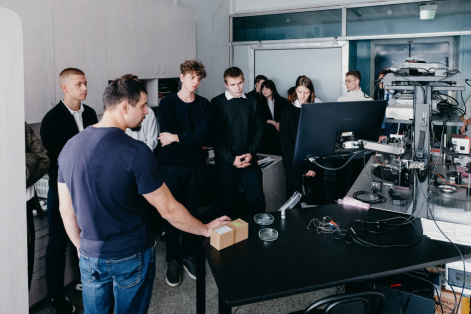Students of the RAS-supported schools learnt about lasers: a discovery that changed the world
16 November 2022 г.

Vasily Arkhipkin, Doctor of Physical and Mathematical Sciences, Professor, Head of the Laboratory of Coherent Optics, told about the personality, heroic biography and scientific and organizational merits of the Soviet and Russian physicist, one of the founders of quantum electronics, Academician Nikolai Basov.
In the fifties of the last century, Nikolai Basov and Alexander Prokhorov were pioneers in the field of radio spectroscopy, and the generation of stimulated emission using molecular beams was one of the results of their work. For these achievements, Soviet physicists along with the American scientist Charles Townes, who independently realized the similar idea, were awarded the Nobel Prize in Physics in 1964. The word "laser" is an abbreviation for Light Amplification by Stimulated Emission of Radiation. Despite the foreign origin of the abbreviation, Russian scientists made a huge contribution to the creation of the laser.
Deputy Director for Research of the L.V. Kirensky Institute of Physics, Candidate of Physical and Mathematical Sciences, Andrei Vyunyshev in his lecture "Lasers: background and history of creation" told the schoolchildren about the great discoveries of the early 20th century which predetermined the creation of the laser.
On May 16, 1960, the American physicist Theodore Maiman made the world's first laser, generating coherent light in the red region of the spectrum in a ruby crystal. The results of the work were published in the journal Nature.
Followers of the school of Nikolai Gennadievich Basov work not only in Moscow, but all over Russia, including Krasnoyarsk. These are several laboratories that are part of the department of optics. Many books have been published on this topic, including the one edited by Academician Basov. Ivan Timofeev, Doctor of Physical and Mathematical Sciences, Head of the Laboratory of Photonics of Molecular Systems, brought this book to schoolchildren during his report "Microlasers and Metasurfaces". According to him, this book does not lose its relevance. Such great discoveries that glorified physics, such as uranium technology, transistor, laser, satellite, were made more than 50 years ago. Our electronics is developing faster and faster, there are more and more cameras in gadgets, but there are no fundamentally new physical laws there.
“We went through the industrial revolution, now the information revolution. The nanorevolution awaits us in the future. Despite the popularity of the topic of nanotechnology, there are much more scientific articles on lasers and optical technologies. In just one year, as many articles were published with the keyword "laser" as in 20 years with the keyword "nanomaterial". By the number of scientific articles on the topic of lasers, Russian science is in 4th place in the world, which indicates the relevance and importance of this area.”
The commemorative readings ended with a report entitled “Lasers in Science and Technology” which was made by Denis Ikonnikov, Candidate of Physical and Mathematical Sciences, Researcher at the Laboratory of Coherent Optics: “In addition to science, lasers have revolutionized technology and everyday life. With their help, surgical operations are performed today, music and films are recorded, furniture is made and many other things.” This was a sort of good theoretical preparation for the schoolchildren before the excursion to the laboratory of coherent optics and molecular spectroscopy.
During the tour, Andrey Vyunyshev told them about the study of optical and spectral properties of crystals and structures, laser methods for studying substances and elementary processes in nature. The guests got acquainted with scientific equipment, including laser systems and other measuring equipment.
In the laboratory of molecular spectroscopy, students learnt about such a promising area as the study of liquid crystals and where they are used, they saw how the structure of a liquid crystal looks like under a microscope. The students learnt from Senior Researcher Alexander Krylov, Candidate of Physical and Mathematical Sciences, about crystalline porous materials made from organic and inorganic components, for example, from metal ions bound together by organic molecules.
The information partner of the event was the Regional Science Foundation.
Share:
